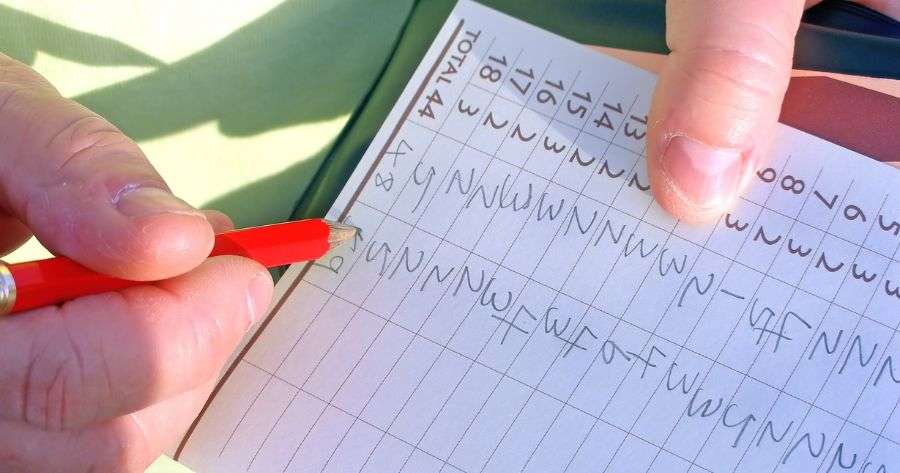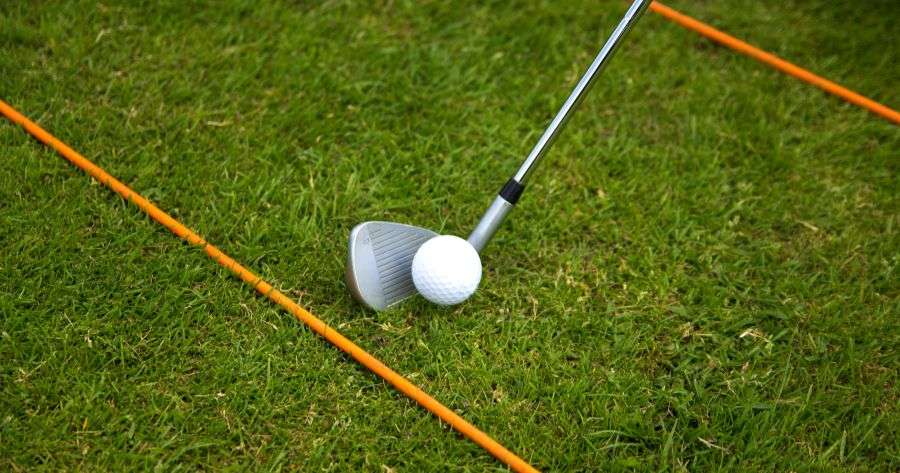
As a beginner shooting between 110-120, breaking 100 in golf felt like a distant dream for me…
Just as it might for you.
If you think about it every golfer, when they’re starting, has this goal in mind.
But despite my numerous attempts and not-so-extensive practice sessions, scoring below 100 continued to be a challenging milestone for me.
Fun fact: this elusive goal is a hurdle that many golfers face, with only about 50% ever achieving it. And even if your goal is to break 100, trying to break 100 consistently is another task altogether.
But this journey is more than just a test of skill; it’s a rite of passage that marks your progress in the game.
In this article, we’ll jump into practical strategies on how to break 100 in golf.
From dialing in your pre-game and pre-shot ritual to making smart course management decisions throughout the round, we’ll cover the essential tactics that can help you finally reach that coveted score.
Whether you’re a seasoned player who can’t break 100 or a newcomer eager to fast-track your success, these insights will guide you toward your goal.
So if you want to know more how to break 100 in golf, such as:
Then this post is for you!
Let’s jump in.
What is the Significance of Breaking 100 in Golf?
Before we jump into the tips, let’s understand why there’s such a need to break 100.
You see for the casual golfer or high handicapper, it’s like this elusive animal that less than half of the golf population will ever see.
Some golfers can break it in a few months of solid dedication, or there are seasoned golfers who never see it all.
Hitting this elusive score is more than just bragging rights…
It’s a testament to your growing skills and dedication on the green.
Trust me…
The journey to get to 99 is lined with frustration, doubt, and a decent amount of golf balls you’ll never see again.
But, the sweet, sweet victory of seeing a two-digit number on your scorecard? Priceless.
Is Breaking 100 in Golf Good?
Let’s dive right in…
Is breaking 100 in golf good? In short, hell ya, especially if you’re just starting.
It’s like joining a club where the secret handshake is just a knowing nod because, well, you just accomplished what many players can’t do.

It’s a milestone that screams “OK, OK. I’m getting the hang of this!” and it puts you ahead of 45% of your fellow swingers.
But what does it mean?
In the grand scheme of things, breaking 100 is just another stepping stone to your next goal, breaking 90.
See in the sub-100 game, you’re not worrying too much about contact anymore because you’re pretty decent at it.
Instead, your strategy starts to matter just as much as your swing.
We’re talking about adopting a gameplay that’s more smooth, more calculated, and with a touch less chaos.
It’s about choosing a reliable club you can count on instead of trying hero shots.
You might think it’s all about power and hitting that tiny golf ball into oblivion, but seasoned players know better.
They’ve learned the art of playing smart.
Speaking of playing smart, here are 15 tips to help you break 100 fast.
15 Tips – Simple Strategy To Break 100 Consistently
Try to incorporate the following tips the next time you play golf.
1 – Master 5 clubs

Believe it or not, beginners only need five (5) golf clubs in their golf bag to break 100 – yup, just five!
In fact, these same five clubs that I’m going to mention would even manage to break 90.
I know right?
Think back to when you first started.
You probably got a driver and immediately wanted to hit bombs off the deck – beginners usually fall into this trap.
Typically they start by practicing their driver to hit bombs and then move onto their irons, all while neglecting their wedges and putter.
The issue with this approach is that beginners are spread too thin during their practice.
Instead, we suggest that beginners only focus on a handful of clubs and practice them until they get consistent contact and consistent distance.
Boring I know, but it works and I’ll explain why.
First, let’s look at the five clubs to break 100.
They are the putter, a wedge (preferably a Sand Wedge or SW), a pitching wedge (PW), the almighty 7 iron (7i), and lastly a driver or long-distance club.
The driver, in this case, can be replaced with a fairway wood, a 3 or 4-hybrid, or even a 3-iron or 4-iron. The intent of this club is to cover a long distance. If you’re comfortable hitting off the deck with a hybrid, more power to you.
Club #1: Putter
Typical logic here is that all holes have a green, and a putter works best on the green – simple enough.
So unless you’re skilled enough, or lucky enough, to chip in all your balls from the fringe for every hole on the course, use a putter.
It’s probably the most popular club in your bag and one that you’ll use almost all the time.
That’s why it’s the most used club for some of the best players in the world, if not the most.
Club #2: Sand Wedge (SW)
Don’t let the name fool you, a SW is not just for the sand, it can be used to chip around the green as well.
It’s a club with a loft between 52-56 degrees and allows you to get the ball airborne and land it softly on the green.
A few reasons why you need a SW:
- Hitting a high trajectory means getting the ball in the air and avoiding bunkers and other hazards
- Can help with getting out of tough conditions such as rough grass or bunkers
- Used as a “chipping club” to chip shots when you’re around the green
- Provide pitch shots from 40-80 yards depending on the swing (full swing, 3/4 swing, half swing, etc.)
A must-needed golf club for your short game.
Club #3: Pitching Wedge (PW)
A recreational golfer can hit a PW between 100-130 yards, whereas professionals can go 130-150 yards.
Due to the distance it covers, the PW would pair greatly with a driver on a par 4.
On average, a typical 18-hole par 72 would have roughly 8-10 par 4’s.
Depending on the par 4’s distance, a recreational golfer can reach the green using a driver and a PW.
Let’s break it down.
USGA identifies par 4’s with a range of 240-490 yards (435+ being PGA tour length).
For simple calculations, let’s assume the average par 4 for recreational golfers would be in the middle, 365 yards.
If an average golfer can drive the ball 220-240 yards, then to get the ball on the green, the second shot should cover the remaining yards (100 yards -145 yards), which can be achieved with a PW.
If you manage to hit two shots well (driver + PW), then you’re setting yourself up to get a par or birdie!
Additionally, beginners who aren’t comfortable using a SW to chip around the green, prefer to use a PW or a 7-iron to do a bump and run.
Club #4: 7 Iron (7i) or 6 Iron (6i)
The almighty 7-iron, or 6-iron depending on your carry distance.
These mid irons provide so much utility and versatility that it’s considered one of the most popular, if not the most popular irons in a golfer’s bag.
For example, the 7i usually has a 34-degree loft and provides enough of an angle to get it out of rough situations such as rough greens and fairway bunkers.
Additionally, hitting the 7i is a lot easier than hitting the long irons because it’s more closely related to the short irons.
Recreational golfers can expect to hit a 7i between 130-150 yards, whereas pros can generally hit it between 170-190 yards – 200+ if you’re showing off on TikTok!
If you can’t hit these numbers yet, club up to a 6i.
This is why most golfers prefer to hit a 6i or 7i because it covers a long distance as well as it’s fairly easy to hit.
Club #5: Driver or Long Distance Golf Club
Although we’d prefer a driver for the last club, it doesn’t have to be a driver.
As mentioned earlier, this club can be replaced with a fairway wood, a 3 or 4-hybrid, or even a 3-iron or 4-iron.
The intent is to use this club off the tee and to cover a long distance, accurately.
Keyword is accurate.
To consistently break 100, we want to hit the ball in the fairway a lot more than hitting it out of bounds.
Sure we want to hammer the ball 250+ yards from the deck, but if it’s consistently hooking or going out of bounds, then we recommend switching it to something golfers are more comfortable using.
Don’t forget – the goal of this club is to cover a long range without sacrificing accuracy.
2 – Don’t look at your score until the end

No, this isn’t just a wishy-washy mind trick but it does allow beginners to focus on two things.
Firstly, it forces beginners not to worry about the game and the added pressure of breaking 100.
Being generally aware of the score is OK but constantly checking strokes after each hole, is not.
Imagine looking at the score after the front 9.
After some quick calculations, you realize you need to hit a par for the remainder of the round in order to break 100. This can immediately make any golfer dejected and not continue trying as the round progresses.
Too many golfers sabotage their game because they play a mental game of hopscotch, jumping from one score-related thought to another.
Golf is a game of staying present—each shot is a step towards that sub-100 score, not a countdown to it.
Lastly, removing the pressure of the score allows you to focus on more important aspects of the game, such as immersing yourself in the process of each shot.
Going through the process of alignment, visualization, and address ingrains the fundamental habits all great golfers have.
Regardless of the outcome, whether it’s good or bad, you still have a process you can constantly rely on.
3 – Be Early and Warm Up – PGA Tour Verified
This is a no-brainer.
Before a big tournament, pros usually arrive at the course 2-2.5 hrs before their tee time.
They take time to activate their muscles to get the blood flowing and spend at least 1-1.5 hrs warming up to some drills such as chipping, and hitting some irons – this includes going through their bag and hit every shot.
Additionally, they’re also known to spend upwards of 30 minutes on the putting green just to gauge the speed and alignment.
If you’re serious about breaking 100, be serious about your preparation.
Start to develop a “game day” routine.
Optimize your wake-up time, eating habits, and drills to practice once you arrive at the course. This allows your mind and body to prepare for the day.
Again, this is a no-brainer. If pros do it, you should too.
4 – Stick To One Golf Course
In the quest to help you break 100, it’s best to stick to one course and one course only – preferably a par 72 course so you have a better idea of your overall score.
Knowing the ins and outs of a course is extremely advantageous for any golfer, regardless of skill level.
It allows you to approach each hole with the confidence of knowing which club to use, which shots to take, and where the unexpected hazards are.
This process will not only strengthen your course management skills, it will reinforce a strong mental game because you’ll be comfortable with each shot since you’ve done it before.
5 – Practice Alignment

Do you slice or hook your golf shots? An unintentional shot shape I somehow mastered.
Maybe you don’t slice or hook but instead, you hit it straight down the line, but it’s not where you were aiming.
Chances are, it’s due to alignment issues.
Beginners think that aligning the club face is all that’s needed to hit a straight and accurate shot, unfortunately that’s only 1/5th of the solution.
To hit a straight shot, you need to align the club face towards the target.
Additionally, your feet, knees, hips, and shoulders should be parallel to your target resulting in a square stance.
A big issue beginners make is that they align the club face towards the target, but their body (feet, knees, hip, and shoulders) are also aligned towards the target, positioning themselves in a closed stance – which may result in a draw, a pull, or worst case, a hook.
If they align their body away from the target, they position themselves in an open stance – which may result in a fade, a push, or worst case, a slice.
To practice alignment, use two alignment sticks.
One stick will be positioned one club head length under the ball, and the other stick positioned one club length above your feet.
The stick positioned under the ball will aim towards your target and the stick positioned by your feet will aim in parallel to your target.
Practice hitting shots with this method until it becomes second nature to align yourself in a squared stance.
6 – Develop A Pre-Shot Routine
All golfers should develop a pre-shot routine.
Whether you’re a novice or an amateur, it’s a process you can rely on regardless of the outcome.
Study any professional golfer and you may notice they repeat the same movements prior to taking a shot.
Their mental checklist usually follows something like this:
- Choose the right club
- Determine their line to the target
- Choose an intermediate target for proper alignment
- Do a few practice swings
- Visualize the shot they want to take
- Address the ball using their club instead of their feet
- They commit to their line and intermediate target
Developing a pre-shot routine allows you to calm your nerves, gain confidence with each shot, and sets your mentality to something familiar.
7 – Know Your Club Distance
We can’t stress enough the importance of understanding how far each of your clubs go, especially the main 5 clubs (minus the putter) we mentioned above.
If you stick to the main 5 clubs, getting a rough carry/total yardage estimate on your 7i, PW, and SW will drastically reduce your score because you won’t severely overshoot or undershoot your target, which will give you more confidence in your upcoming shots.
The main distances you should understand are the following:
- 7i (full swing)
- PW (full swing, 3/4 swing, half swing, 1/4 swing)
- SW (3/4 swing, half swing, 1/4 swing)
Once you’re comfortable with those distances then the remaining irons would range between 15-25 yards, even more for the longer clubs.
So if your average distance on your 7i is 145 yards, then a 6i would be 160-165 yards, and an 8i would be 125-130 yards.
8 – Know Your Distance To The Green or Flag

Although knowing the distance of each club is important, knowing your distance to the flag is equally important.
The distance gap between clubs can range from 15-20 yards. Even bigger for the longer irons, hybrids, and woods.
If you don’t know the actual distance to the green or the flag, you could potentially choose the wrong club and be short 20 yards, or long 20 yards.
And instead of being on the green and putting in your next shot, you have to take an additional stroke to account for the gap you miscalculated – this obviously will lead to a bogey or even worse, a triple.
Save yourself some strokes and stop guessing – get a rangefinder.
This tool alone can help you hit more greens in regulation.
If you can’t afford a rangefinder, use a Golf GPS App such as 18Birdies.
It allows you to track the distance from your phone’s GPS to the pin. It even gives you the yardages from the front and back of the green – pretty sweet.
Although it may not be as accurate as a rangefinder, it’s decent enough to help beginners choose the right club for their approach shot or give them a shot to hit the green.
9 – Use Bump-And-Run Instead of Chip Shots
This is definitely an underrated shot that many beginners fail to utilize when they’re just around the green.
Beginners feel they need to hit a chip shot or a flop shot because that’s what they see on social media and let’s be honest, it looks damn cool.
Unfortunately, those shots have a high risk-to-reward ratio.
Skull the shot and the ball goes flying, completely missing the green entirely, or skirts off to the edge for a longer putt.
Thin the shot and the ball moves a few feet and doesn’t even reach the green.
Luckily a bump and run helps minimize these risks by using a stance (putting stance) and shot you’re more familiar with.
How to do a bump and run in golf?
- Use a lower lofted club such as a 7i
- Determine your line as if you’re putting
- Move your hand further down the grip
- As you choke down on the club, the heel will be off the ground leaving the toe of the sole as the only part touching the surface
- Align the ball closer to your back foot
- Address the ball as if you’re putting
- Posture and stance similar to your putting stance
- Commit to your line
- Hit the ball using your putting stroke
10 – Focus on Your Fundamentals

Let’s face it, golf can be very intimidating.
The different terminology, the theory, and the mechanics alone can be very daunting to understand and execute, especially for beginners.
Ask any golfer – the simple act of just “hitting the ball” is already tough and requires multiple factors to be executed properly.
And even though there are thousands of variables you need to consider in order to “pure” the ball, chances are it’ll fall under one of the seven key fundamental categories:
- Grip
- Posture / Stance
- Wrist
- Ball Position
- Alignment
- Swing Mechanics (Backswing, downswing, and follow-through)
- Rotation
To be a consistent ball striker, you need to understand how each category affects one another.
For example, depending on your grip (overlap, interlock, or baseball) and your grip strength (strong, weak, or neutral), it can drastically change the mechanics of your wrist and the compensation needed to ensure the club face is squared on impact.
Once you understand the categories, go to the range and practice to see what feels comfortable. Before you know it, you’ll become a consistent ball striker.
11 – Deliberate Practice – How to Use the Range Effectively

Don’t go to the driving range for the sake of smashing the ball as far as you can.
Even though it’s fun, it’s not productive and it won’t help you towards your goal of breaking 100.
Instead, try to incorporate the following drills:
- Make Ball Contact
- If you’re struggling with slicing, hooking, topping, and even chunking the ball, your first drill should be focused on your swing
- Practice your takeaway, backswing, downswing, impact, and follow-through
- Practice hitting shots from your takeaway position (club shaft should be parallel to the ground) and work your way up
- The point of this exercise to gain consistency with hitting the ball
- Hit a Target
- Grab a wedge, or at most an 8-iron, and try to hit a target
- The point of this exercise is to control your accuracy using a short iron or wedge
- For example, if a flag is 50 yards away, take a wedge you feel comfortable with at that range and try to hit it
- Same Club, Different Targets
- Grab a GW, PW, 9-iron, or 8-iron, and try to hit different targets
- I would suggest picking the longest club you feel accurate with
- The point of this exercise is to master distance and strength control
- For example, if you choose a 9-iron, you could potentially use that club for distances between 20-130 yards. Find targets throughout that range and practice hitting those flags.
- Same Target, Different Clubs
- Pick a target roughly 120 yards away
- Start with the club that can reach that distance, for example, an Approach/Gap Wedge
- Once you hit that distance, move on to the next club up, which would be a PW
- The point of this exercise is to feel how the different trajectories of the club, can affect how you would approach each target
12 – Limit Your Driver
Let’s get real for a second.
The driver, with all its power and glory, is a fickle friend.
It promises to send the ball soaring across the fairway, but without the precision and control of other clubs, it’s just as likely to send your scorecard into a tailspin.
Remember, golf isn’t a strongman competition – it’s about strategy, finesse, and making smart choices.
So, when should you pull out the driver? Well, it depends.
If the fairway is wide and forgiving and you’ve been hitting your driver well that day, go for it.
But if it’s a narrow passage lined with hazards, it’s time to dial it back.
Opt for a 3-wood, hybrid, or a long iron to keep the ball safely on the fairway.
The goal is to avoid those scorecard-sabotaging mistakes that come from biting off more than you can chew.
13 – Play From The Correct Tees
Most golf courses have color-defined tee boxes that consist of blacks, blues, whites, and reds, all of which represent a certain distance to the green.
Blacks are usually the furthest away, and reds usually are the closest to the pin.
As a beginner, you should strive to tee off from the white or red tees.
“But red tees are for the girls” – no they’re not.
This isn’t ego golf. Don’t be that golfer who’s more interested in “flexing” their skills when there’s none there.
This is especially important for golfers trying to “play from the tips” (playing from the rearmost set of tees – usually the black tees).
If you can’t hit the golf ball far and on the fairway then why make things difficult by adding more yards to your tee shot?
Instead, just enjoy your game. Focus on your routine. Focus on your course management.
Golf is already a hard game and trying to keep up with the Joneses just adds another layer to an already complicated sport.
14 – Lay Up Instead of Hero Shots
Picture this: You’re standing on the fairway, staring down a long par 5 with water just before the green.
The voice inside your head is contemplating what to do, while your buddies are chanting “Hero shot, hero shot”.
Here’s a hint: mute them!
You don’t need to hit the green in your second shot (for par 4’s) or third shot (for par 5’s).
As a beginner, it’s important to gain confidence with your shots instead of trying to hit hero shots you’re not comfortable with – this is why I recommend laying up.
Laying up means choosing to hit a shorter, more controlled shot, setting yourself up for an easier next shot.
It may not feel as glamorous as going for the green in two, but it’s a strategy that pays off.
Honestly, hitting a golf ball over a water hazard with a wood or 3i, hoping it lands softly on the green, is more Hollywood than reality for most amateur golfers.
And while the dream of sinking that eagle putt is sweet, the risk of ending up out of bounds is real.
Instead, picking a shorter club and safely landing before the hazard can set you up for a stress-free approach and a solid chance at par—or even a birdie.
15 – Learn To Lag Putt To Break 100 Fast

This tip alone will shave off 5-10 strokes in your next round of golf.
If you do the mental math to break 100, it equates to 9 double bogeys and 9 bogeys (or a mixture of pars and triple bogeys) – that’s it.
Unfortunately, a lot of those extra strokes come from three-putting almost every hole.
I find that beginners usually make the following mistakes when they’re on the green:
- They don’t take the time to read the green
- They don’t know the strength/power needed to cover short putts and long putts
- They always try to “hole it out” with one shot
Instead, I suggest incorporating lag putting.
Lag putting is the strategy of focusing on distance control and getting the ball close to the hole, instead of trying to hole it out.
For example, when you’re on the green and you have a long putt ahead of you, try to get the ball within 2-3ft of the hole, this will ensure you finish the hole with a two putt instead of the dreaded three putt.
Final Thoughts On How To Break 100 in Golf For High Handicappers
Listen, breaking 100 and shooting in the 90’s is a significant milestone for anyone, including high handicappers.
It represents progress, determination, and a commitment to improving one’s game.
By using this strategy and the 15 tips I’ve outlined, you should be able to play your best golf round.
One last thing, it’s not just about the score – it’s about enjoying the game and hanging out with your friends.
Happy golfing!
Before You Go…
If you’re serious about lowering your score and hitting in the 90’s (or even lower) you need to master your short game.
In fact, the short game is one of the key elements that I changed in my game that allowed me to break 90 in 7-8 months.
That’s why I created two posts that talk about my favorite short game wedges, the 52 and 60 degree wedges.
Check it out:
- 52 Degree Wedge: A Beginner’s Guide To Improving Your Short Game
- 60 Degree Wedge – 10 Things To Know About Your Lob Wedge
Or, if you really think you need guidance, consider getting golf lessons:
